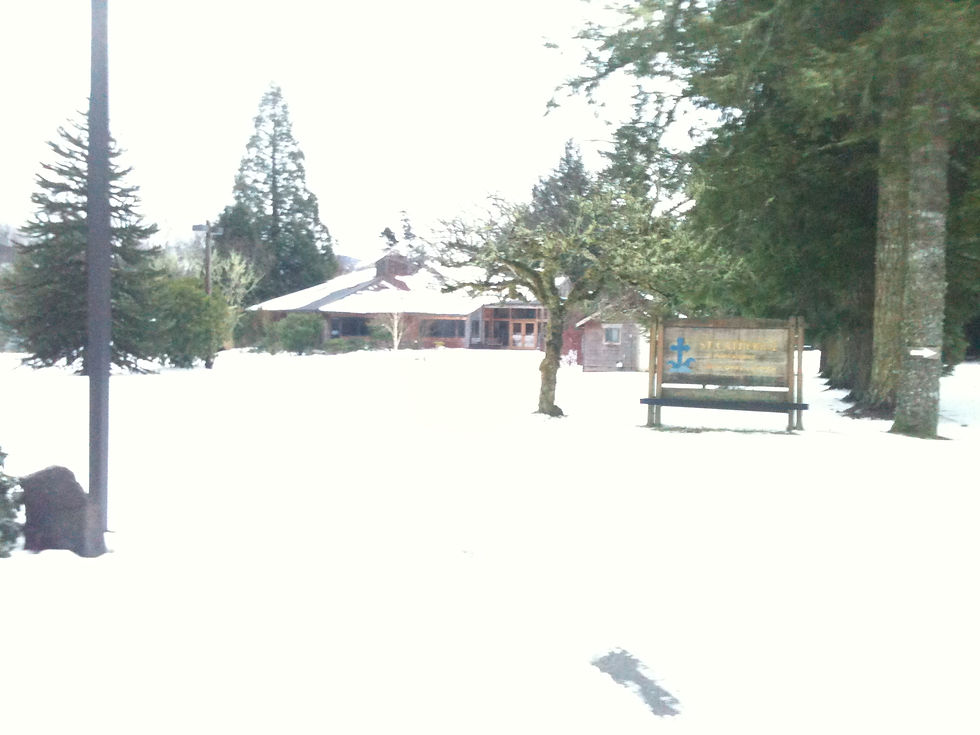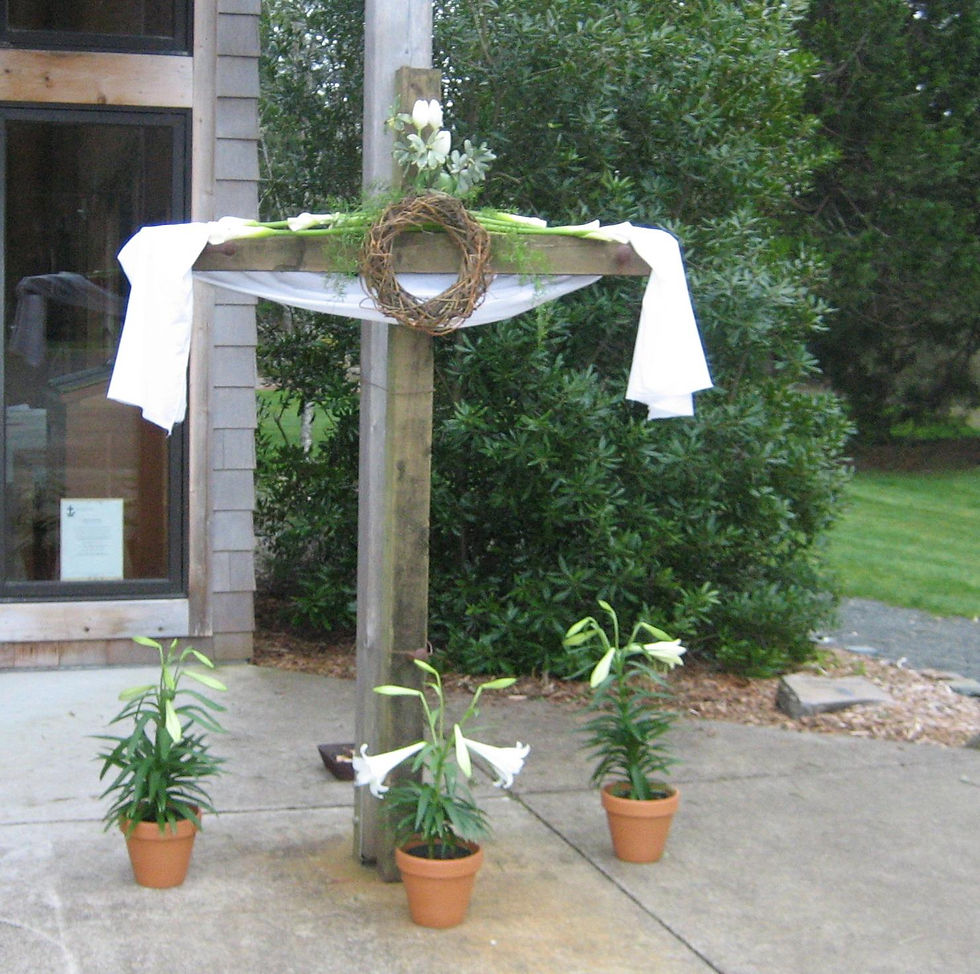

OUR HISTORY | NUESTRA HISTORIA
St. Catherine Episcopal Church was dedicated on September 11, 2005. The following article, printed in the Oregon Episcopal Church News before the church was completed, details what went into the planning process.
La Iglesia Episcopal Santa Catalina se inauguró el 11 de septiembre de 2005. El siguiente artículo, impreso en Oregon Episcopal Church News antes de que se completara la construcción de la iglesia, detalla el proceso de planificación.
St. Catherine’s vision of sacred space becomes a reality.
By Deirdre Steinberg, editor, The Oregon Episcopal Church News
For five years it was only a dream — a vision of a sacred space. But now it is a looming reality. On Sept. 12, Bishop Johncy Itty will put shovel to earth and spade up a chunk of soil for the firstever church building of St. Catherine, Manzanita. The small mid-coastal diocesan mission of 100 congregants (and many Anglican vacationers who return year after year) has been planning and raising money for the new structure since 1999, says Mary Cramer, chair of the building fund. Phase I of the construction is slated to take nine months from groundbreaking. St. Catherine began as a mission church of Calvary, Seaside in 1954. It has remained a mission church and has always been in rented space, which hampered what congregants could create as a house of worship, explains Paul Barthelemy, St. Catherine’s vicar. “There was a real will to build a church here and a mystical sense that we needed it,” he adds. Frank Dorscheimer, a long-time diocesan leader who died this past summer, was a major force in gathering up this vision and moving it forward, says Barthelemy. — Phase I — When Phase I is complete the church will have a sanctuary, sacristy, entrance hall, narthex, bathrooms and some offices. The parish hall is Phase II and will need additional fundraising. Through everything from bake and rummage sales to large contributions from individuals, St. Catherine’s has raised $680,804 to make its dream come true. Another $190,000 was raised to buy the tranquil spot where the church will sit on Highway 101 between Manzanita and Nehalem. “We are all amazed at how successful the fundraising has been. Frank Dorscheimer’s vision and belief in St. Catherine’s was the beacon that began the process and his spirit has continued to lead us forward,” says Cramer. “Paul’s leadership added direction and strength to the spirit and vision.” — ‘Green’ worship — Tom Bender of Neahkahnie is the architect for St. Catherine’s. He has won several national and international awards for his environmentally-friendly “green” designs. In 2001, he was the National Award Winner for Sustainable Design of the American Institute of Architects and in 2002 was cited by the same group for designing one of the Top 10 Green Buildings of the year. In 2002, the 1000 Friends of Oregon named him Developer of the Year. “The parishioners said they wanted to create a place that connected worshipers more deeply with the rest of creation and they also wanted to have it be environmentally responsive,” says Bender. “What we’ve done is tried to make the garden a sacred space in itself and have the sanctuary be a place to focus inward.” To do this, Bender has not flooded the sanctuary with electric light, but designed a skylight that brings light down onto the altar. Low windows on two sides of the sanctuary will bring in sunlight rippling of the surface of the outside reflecting pool and focus it onto the ceiling of the sanctuary, creating a meditative feeling in the worship space. The garden is a satisfying mixture of wetlands, forest and open lawn with a meditation walkway. To maximize the greening of St. Catherine’s architecture, Bender plans to use local materials, reducing energy and operating costs. This will be accomplished, he says, by choosing heating and cooling systems that are more environmentally sustainable. There will be more insulation than is called for by code. Instead of air-conditioning, a system that pre-cools the sanctuary floor will be installed using water from a sand point well for the few days a year that it is actually hot on the coast. For heating, Bender has recommended a propane-fired water heater that will circulate hot water through the floors and baseboard heaters. — Fair compromises with architectural flair! — “The people of St. Catherine’s have opened their hearts to my ideas and they’ve been wonderful to work with,” says Bender, who did his first green building 35 years ago in Minneapolis, MN, when green was not much of a concept taught in architectural schools or employed commercially. He says that everyone on the building committee and the congregants themselves have been “very clear on what they want to see happen and why.” When conflicts of vision have arisen, Bender feels they have been accommodated. For example, some worshipers did not want to see others while they prayed, it would be too distracting. Others felt energized and moved when seeing others pray. The compromise was not to make straightahead pews or circular pews, but, rather, a “semi-curved arrangement” that will allow people to choose where to sit — to either block out or see others while praying. “Nothing has prepared us for the sense of wonder, gratitude and community that we feel as the process has moved forward toward construction,” says Cramer. “We have been truly blessed.” Additional information: St Catherine’s became separate mission on January 1, 1984.

La visión de Santa Catalina del espacio sagrado se hace realidad.
Escrito por Deirdre Steinberg, editora, The Oregon Episcopal Church News
Durante cinco años fue solo un sueño, una visión de un espacio sagrado. Pero ahora es una realidad que se avecina. El 12 de septiembre, el obispo Johncy Itty pondrá una pala en la tierra y excavará un trozo de tierra para la primera construcción de la iglesia de Santa Catalina, Manzanita. La pequeña misión diocesana de la costa media de 100 feligreses (y muchos vacacionistas anglicanos que regresan año tras año) ha estado planificando y recaudando dinero para la nueva estructura desde 1999, dice Mary Cramer, presidenta del fondo de construcción. La Fase I de la construcción está programada para tomar nueve meses desde la inauguración. Santa Catalina comenzó como una iglesia misionera de Calvary, Seaside en 1954. Se ha mantenido como una iglesia misionera y siempre ha estado en un espacio alquilado, lo que obstaculizó lo que los feligreses podían crear como una casa de culto, explica Paul Barthelemy, vicario de Santa Catalina. “Había una voluntad real de construir una iglesia aquí y un sentido místico de que la necesitábamos”, agrega. Frank Dorscheimer, un líder diocesano de mucho tiempo que murió el verano pasado, fue una fuerza importante para reunir esta visión y hacerla avanzar, dice Barthelemy. — Fase I — Cuando se complete la Fase I, la iglesia tendrá un santuario, sacristía, vestíbulo, nártex, baños y algunas oficinas. El salón parroquial es la Fase II y necesitará recaudación de fondos adicional. A través de todo, desde ventas de pasteles y artículos usados hasta grandes contribuciones de personas, Santa Catalina ha recaudado $680,804 para hacer realidad su sueño. Se recaudaron otros $190,000 para comprar el lugar tranquilo donde se ubicará la iglesia en la autopista 101 entre Manzanita y Nehalem. “Todos estamos asombrados de lo exitosa que ha sido la recaudación de fondos. La visión y creencia de Frank Dorscheimer en Santa Catalina fue el faro que inició el proceso y su espíritu continúa llevándonos hacia adelante”, dice Cramer. “El liderazgo de Paul agregó dirección y fuerza al espíritu y la visión”. — Adoración 'verde' — Tom Bender de Neahkahnie es el arquitecto de Santa Catalina. Ha ganado varios premios nacionales e internacionales por sus diseños “verdes” respetuosos con el medio ambiente. En 2001, fue ganador del Premio Nacional de Diseño Sostenible del Instituto Americano de Arquitectos y en 2002 fue citado por el mismo grupo por diseñar uno de los 10 mejores edificios ecológicos del año. En 2002, 1000 Friends of Oregon lo nombró Desarrollador del Año. "Los feligreses dijeron que querían crear un lugar que conectara a los fieles más profundamente con el resto de la creación y que también querían que fuera ambientalmente sensible”, dice Bender. “Lo que hemos hecho es tratar de hacer del jardín un espacio sagrado en sí mismo y hacer que el santuario sea un lugar para enfocarse hacia adentro”. Para ello, Bender no ha inundado el santuario con luz eléctrica, sino que ha diseñado una claraboya que ilumina el altar. Ventanas bajas en dos lados del santuario traerán la luz del sol ondeando en la superficie de la piscina reflectante exterior y la enfocarán en el techo del santuario, creando una sensación de meditación en el espacio de adoración. El jardín es una mezcla satisfactoria de humedales, bosques y césped abierto con una pasarela de meditación. Para maximizar la ecologización de la arquitectura de Santa Catalina, Bender planea utilizar materiales locales, reduciendo los costos de energía y operación. Esto se logrará, dice, eligiendo sistemas de calefacción y refrigeración que sean ambientalmente más sostenibles. Habrá más aislamiento del que exige el código. En lugar de aire acondicionado, se instalará un sistema que enfría previamente el suelo del santuario utilizando agua de un pozo de arena durante los pocos días del año que hace calor en la costa. Para la calefacción, Bender ha recomendado un calentador de agua a propano que hará circular el agua caliente a través de los calentadores de pisos y zócalos. — ¡Compromisos justos con estilo arquitectónico! — “La gente de Santa Catalina ha abierto sus corazones a mis ideas y ha sido maravilloso trabajar con ellos”, dice Bender, quien hizo su primer edificio ecológico hace 35 años en Minneapolis, MN, cuando el verde no era un gran concepto. enseñado en escuelas de arquitectura o empleado comercialmente. Él dice que todos en el comité de construcción y los propios feligreses han sido "muy claros sobre lo que quieren que suceda y por qué". Cuando han surgido conflictos de visión, Bender siente que han sido acomodados. Por ejemplo, algunos adoradores no querían ver a otros mientras rezaban, sería una distracción demasiado grande. Otros se sintieron energizados y conmovidos al ver a otros orar. El compromiso no fue hacer bancos rectos o bancos circulares, sino, más bien, un "arreglo semicurvo" que permitirá a las personas elegir dónde sentarse, ya sea para bloquear o ver a los demás mientras oran. “Nada nos ha preparado para la sensación de asombro, gratitud y comunidad que sentimos a medida que el proceso avanza hacia la construcción”, dice Cramer. “Hemos sido verdaderamente bendecidos”. Información adicional: Santa Catalina se convirtió en misión independiente el 1 de enero de 1984.





